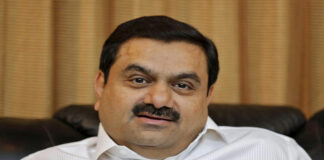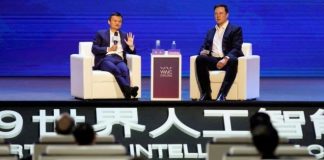FEBRUARY 7, 2021
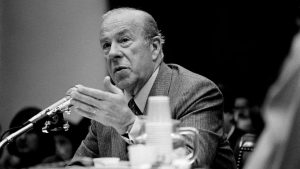
George Shultz, then secretary of state, testifying to Congress during the Iran-contra affair in 1986. – Paul Hosefros/NYTimes
George P. Shultz, who presided with a steady hand over the beginning of the end of the Cold War as President Ronald Reagan’s often embattled secretary of state, died on Saturday at his home in Stanford, Calif. He was 100.
His death was announced by the Hoover Institution, where he was a distinguished fellow. He was also professor emeritus at Stanford’s Graduate School of Business.
Mr. Shultz, who had served Republican presidents since Dwight D. Eisenhower, moved to California after leaving Washington in January 1989. He continued writing and speaking on issues ranging from nuclear weapons to climate change into his late 90s, expressing concern about America’s direction.
“Right now we’re not leading the world,” he told an interviewer in March 2020. “We’re withdrawing from it.”
He carried a weighty résumé into the Reagan White House, with stints as secretary of labor, budget director and secretary of the Treasury under President Richard M. Nixon. He had emerged from the wars of Watergate with his reputation unscathed, having shown a respect for the rule of law all too rare in that era. At the helm of the Treasury, he had drawn Nixon’s wrath for resisting the president’s demands to use the Internal Revenue Service as a weapon against the president’s political enemies.
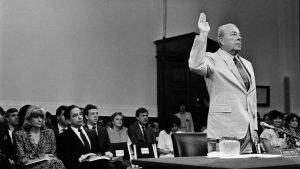
Mr. Shultz, then secretary of state, being sworn in before the Iran-contra panel in 1987. – Paul Hosefros/NY Times
As secretary of state for six and a half years, Mr. Shultz was widely regarded as a voice of reason in the Reagan administration as it tore itself asunder over the conduct of American foreign policy. He described those struggles as “a kind of guerrilla warfare,” a fierce and ceaseless combat among the leaders of national security.
He fought “a battle royal” in his quest to get out the facts, as he later testified to Congress during the Iran-contra affair. The director of the Central Intelligence Agency, William J. Casey, followed his own foreign policy in secret, and the State Department and the Pentagon constantly clashed over the use of American military force. Estranged from the White House, Mr. Shultz threatened to resign three times.
Mr. Shultz was summoned to Camp David and handed the wheel of American foreign policy in June 1982. Initially deemed too politically moderate by Reagan’s advisers, he had been passed over for the post of secretary of state the previous year. (The position had gone to Alexander M. Haig Jr., the mercurial and combative general who lasted barely 18 months before he abruptly left office amid fierce disputes over the direction of diplomacy and the projection of American power.)
The Middle East was exploding, the United States was underwriting covert warfare in Central America, and relations with the Soviet Union were at rock bottom when Mr. Shultz became the 60th secretary of state.
Moscow and Washington had not spoken for years; nuclear tensions escalated and hit a peak during his first months in office. The hard work of replacing fear and hatred with a measure of trust and confidence took place in more than 30 meetings with Mr. Shultz and the Soviet foreign minister, Eduard Shevardnadze, between 1985 and 1988. The Soviets saw Mr. Shultz as their key interlocutor; in private, they called him the prime minister of the United States.
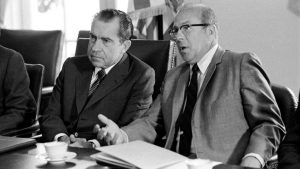
Mr. Shultz with President Richard Nixon in the White House cabinet room in 1970. – George Tames/NY Times
Continuous meetings between Mr. Shultz and Mr. Shevardnadze helped ease the tensions between the superpowers and paved the way for the most sweeping arms control agreement of the Cold War, the Intermediate-Range Nuclear Forces Treaty. Ratified in June 1988, it banned land-based ballistic missiles, cruise missiles and missile launchers with ranges of up to 3,420 miles. Within three years the two nations had eliminated 2,692 missiles and started a decade of verification inspections.
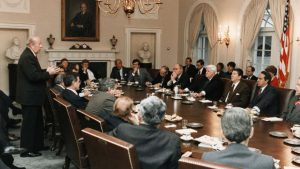
Mr. Shultz, standing, briefs President Reagan and a meeting of cabinet members and congressional leaders about nuclear arms negotiations between the United States and the Soviet Union in 1984. – The White House, via Getty Images
The treaty remained in force until August 2019, when President Donald J. Trump scrapped it, contending that Russia had broken the accord by developing a new cruise missile.
Almost alone among the members of the Reagan team, Mr. Shultz had seen early on that the new Soviet leader, Mikhail S. Gorbachev, and his allies in Moscow were different from their predecessors. The rest of the national security team, and especially Reagan’s defense secretary, Caspar W. Weinberger (known as Cap), had scoffed at the idea that the Kremlin could change its tune.
“Many people in Washington said: ‘There is nothing different, these are just personalities. Nothing can be changed,’” Mr. Shultz recounted in an oral history of the Reagan administration. “That was the C.I.A. view; that was Cap’s view; that was the view of all the hard-liners.”
“They were terribly wrong,” he added.
The world seemed on the verge of a lasting peace when he left office; the Berlin Wall still stood, but not for long. “It is fair to say that the Cold War ended during the Reagan years,” Mr. Shultz wrote in his 1993 memoir, “Turmoil and Triumph: My Years as Secretary of State.” The easing of four decades of grinding tension changed the global landscape. There would be fewer nuclear weapons pointed at great cities, fewer proxy wars in Africa, Asia and Latin America.
But a lethal force was rising in Afghanistan, where American-supplied weapons in the hands of Afghan rebels killed Soviet occupying forces throughout the 1980s. Both Moscow and Washington had poured billions of dollars into the fight, and both sides continued to support rival Afghan factions after the Soviets pulled out in February 1989.
“We assert confidently our right to supply our friends in Afghanistan as we see the need to do so,” Mr. Shultz announced in April 1988. American arms had helped empower a generation of holy warriors who had bled the Red Army, but who would eventually shelter and support the Qaeda terrorists who struck the United States on Sept. 11, 2001.
Strategies Against Terror
The United States was hit by terrorist attacks repeatedly in the Reagan years; the worst was the October 1983 suicide bombing of the Marine Corps headquarters at the Beirut International Airport that killed 241 Americans. They had been sent to Lebanon as peacekeepers while the United States tried and failed to broker a deal among the leaders of Israel, Lebanon and Syria after the 1982 Israeli invasion of Lebanon.
Mr. Shultz had proposed a new strategy of counterterrorism — “preventive or pre-emptive actions against terrorists before they strike,” as he said in a June 1984 speech. The idea won only muted support at the time, but it became a tenet of President George W. Bush’s “war on terror.”
Mr. Shultz decisively lost the battle for control of foreign policy in the Western Hemisphere. The White House, the National Security Council and the C.I.A. believed that the rise of a left-wing government in Nicaragua foreshadowed a chain reaction that could inflame all of Central America. They chose to fight back through covert action, secret paramilitary operations and support for a counterrevolutionary force, the contras. Congress cut off aid to the rebels, but secret operations to support them continued apace.
Reagan’s national security adviser, Vice Adm. John M. Poindexter, and Mr. Casey, the C.I.A. chief, oversaw the secret sale of arms to Iran as ransom for American hostages held in Lebanon. Both men knew that millions of dollars in profits from the arms sales were being channeled covertly to the Nicaraguan rebels, in defiance of the congressional ban.
Mr. Shultz had been kept in the dark about secret presidential directives authorizing the trading of arms for hostages. Chagrined and outraged, he denounced the secret dealings after they were revealed in November 1986, directly challenging Reagan. He came close to losing his job. But alone among the senior members of the Reagan team, he emerged untarnished after the Iran-contra affair unraveled.
The arms-for-hostages deal was “totally outside the system of government that we live by,” Mr. Shultz later told Congress. “I don’t think desirable ends justify means of lying, deceiving, of doing things that are outside our constitutional processes.”
Mr. Shultz knew the consequences of criminal acts and cover-ups. He had lived through Watergate.
On the secretly recorded White House tapes, Nixon railed about Mr. Shultz’s reluctance to use the I.R.S. to investigate and intimidate hundreds of people on the president’s so-called enemies list.
“He didn’t get secretary of the Treasury because he has nice blue eyes,” Nixon said. “It was a goddamn favor to get him that job.”
Nixon named Mr. Shultz labor secretary in January 1969, a post he held for 18 months until he took over the newly formed White House Office of Management and Budget in July 1970. His deputy there was Mr. Weinberger, whose zeal to carry out the president’s demands to cut federal spending earned him the nickname “Cap the Knife.”
“Caspar Weinberger was noted as a big budget cutter,” Mr. Shultz said in an oral history of the Nixon administration. “Nixon railed against the C.I.A. and their lousy intelligence, and said, ‘Cap, I want you to cut the C.I.A.’s budget to one-third its present size.’ Cap would light up like a Christmas tree. Then Nixon said: ‘No. Make it one-half its present size.’ Then we’d leave the meeting, and Cap would be very excited, and I would say: ‘Cap, relax. He’s just showboating.’”
After two years at the budget office, Mr. Shultz became Treasury secretary in June 1972. The previous year, Nixon unilaterally made the dollar inconvertible to gold. That forced the rest of the world to move from a system of fixed rates of exchange for national currencies to a flexible system. Exchange rates ceased to be the way in which governments made monetary policy. Mr. Shultz traveled the world trying to make sure the dollar remained almighty.
He quit the Nixon administration in May 1974, three months before the president resigned in disgrace, the last of Nixon’s original cabinet members to depart. Before his death, he was the oldest surviving member of Nixon’s inner circle and, along with former Secretary of State Henry A. Kissinger, among the last.
After 25 years in academia and government, Mr. Shultz joined the Bechtel Corporation (now Bechtel Group), one of the world’s biggest engineering and construction companies, serving as its president from 1974 to 1982. He was paid nearly $600,000 a year (about $2 million in today’s money) to run its global and domestic operations, which included the Trans-Alaska Pipeline, the Washington Metro subway, King Khalid International Airport in Riyadh, Saudi Arabia, and much of the infrastructure of the Saudi government.
Throughout his years in power in Washington, Mr. Shultz tried to keep one secret out of print: that he had a tiger tattoo on his posterior, a legacy of his undergraduate days at Princeton University. When queried about the tattoo, Phyllis Oakley, a State Department spokeswoman at the time, replied, “I am not in a position to comment.”
Princeton, Then the Pacific
George Pratt Shultz was born in Manhattan on Dec. 13, 1920, the only child of the former Margaret Lennox Pratt and Birl E. Shultz, an official with the New York Stock Exchange. He grew up in Englewood, N.J., and entered Princeton in the fall of 1938.
In his senior year in 1941, he was majoring in economics when Japan attacked Pearl Harbor on Dec. 7. He joined the Marines after graduation and saw combat in the Pacific. He joined the faculty at the Massachusetts Institute of Technology after earning his doctorate in industrial relations there in 1949. His field was labor economics.
In 1955, he took a year’s leave to serve as a senior staff member of President Dwight D. Eisenhower’s Council of Economic Advisers, under its chairman, Arthur F. Burns, who later led the Federal Reserve Board.
Starting in 1957, Mr. Shultz taught at the University of Chicago, where he was dean of its business school from 1962 to 1968. That year he took a fellowship at the Center for Advanced Study in the Behavioral Sciences, a wooded retreat for academics in Stanford. He returned to Stanford after leaving public office and receiving in 1989 the Presidential Medal of Freedom, the nation’s highest civilian honor. Over the next three decades he wrote for academic journals and op-ed pages.
His most recent book, published in the fall, was “A Hinge of History,” written with James Timbie, a longtime State Department adviser. In the book, Mr. Shultz argued that the world is at a pivot point in history, much like the one it reached at the end of World War II, requiring international cooperation in grappling with an era that will bring fundamental changes in education, migration, national security, technology, economics and democratization.
Mr. Shultz was a Marine when he met his future wife of nearly 50 years, Helena M. O’Brien, known as Obie. He was on a rest-and-recreation trip to Kauai, Hawaii, where she was an Army nurse. She died in 1995.
In 1997, he married Charlotte Smith Mailliard Swig, San Francisco’s chief of protocol.The high-society ceremony was held in the city’s Grace Cathedral. He wore black tie with red, white and blue studs of rubies, diamonds and sapphire, and sported a tiger orchid boutonniere.
His survivors include his wife; three daughters from his first marriage, Margaret Ann Shylt Tilsworth, Kathleen Pratt Shultz Jorgensen and Barbara Lennox Shultz White; two sons from his first marriage, Peter and Alexander; 11 grandchildren; and nine great-grandchildren.
The only scandal that touched Mr. Shultz’s personal life began to erupt in 2015. For four years, he had been a member of the board of directors of Theranos, a Silicon Valley start-up founded by Elizabeth Holmes, a young college dropout who claimed to have invented a revolutionary new blood-testing system. His enthusiastic support drew power brokers to the board, including Mr. Kissinger and James Mattis, the retired Marine general who would become President Trump’s defense secretary.
Theranos was valued at $9 billion before whistle-blowers inside the company began talking to a Wall Street Journal reporter, saying the technology did not work as promised. The insiders included Mr. Shultz’s grandson, Tyler Shultz, and the elder statesman pressured him to stay silent.
It was not until Theranos collapsed in 2018 and its founders faced indictment on fraud charges that Mr. Shultz finally acknowledged the “troubling practices” at Theranos, saying in a public statement that his grandson had “felt personally threatened” by their confrontation “and believed that I had placed allegiance to the company over allegiance to higher values and our family.”
A lifelong Republican, Mr. Shultz largely stayed out of the political fray after leaving Washington. But he refused to publicly endorse Mr. Trump in 2016 and in 2020, adding that he did not back his Democratic opponents, either. In an interview with The New York Times in October, however, he offered no criticism of Joseph R. Biden Jr., Mr. Trump’s Democratic challenger at the time. The two had worked together collegially when Mr. Shultz was secretary of state and Mr. Biden was a member of the Senate Foreign Relations Committee. Mr. Shultz said he had recently teased Mr. Biden, who was 77 at the time, telling him, “From my standpoint, you’re a promising young man.”
A Legacy Undone
Mr. Shultz lived long enough to see his most lasting legacy from the Reagan years come largely undone.
The arsenals of the United States and the Soviet Union were bristling with tens of thousands of nuclear weapons when he became secretary of state. Fears of Armageddon approached an all-time high. In June 1983, General Secretary Yuri Andropov warned a former American ambassador to Moscow, Averell Harriman, that the two nations were nearing “the dangerous ‘red line’” of nuclear war.
“I don’t think the Soviets were crying wolf,” Robert M. Gates, the C.I.A.’s top Soviet analyst at the time and later the secretary of defense, observed a quarter of a century later. “They may not have believed a NATO attack was imminent in November 1983, but they did seem to believe that the situation was very dangerous.”
Washington and Moscow had been preparing for World War III since the dawn of the nuclear age. They also had been negotiating a strategic arms limitation treaty since 1969. An agreement signed in 1979 would have reduced both sides’ nuclear arsenals substantially. But after the Soviets invaded Afghanistan that year, the Senate never ratified it.
Mr. Shultz’s crowning arms-control achievement was the 1988 Intermediate-Range Nuclear Forces Treaty, and he was dismayed when President Trump scrapped it in 2019.
“Withdrawing from the I.N.F. treaty was a giant mistake,” Mr. Shultz said in the October interview with The Times. “You lose not only the agreement itself, but you lose all those verification provisions that we worked so hard on.”
Mr. Shultz and Mr. Gorbachev had argued to no avail in a Washington Post op-ed article in 2018 that abandoning the treaty “would be a step toward a new arms race, undermining strategic stability and increasing the threat of miscalculation or technical failure leading to an immensely destructive war.”
Mr. Shultz agonized over that threat. “We desperately need to have a discussion with Russia about this,” he told an interviewer in November 2019. “There is too much loose talk about not just having nuclear weapons, but using them,” he said.
“People have forgotten their power. In my day, I remember nuclear weapons. We knew what they could do. It was very vividly wrong.”
Courtesy/Source: NY Times









































































































